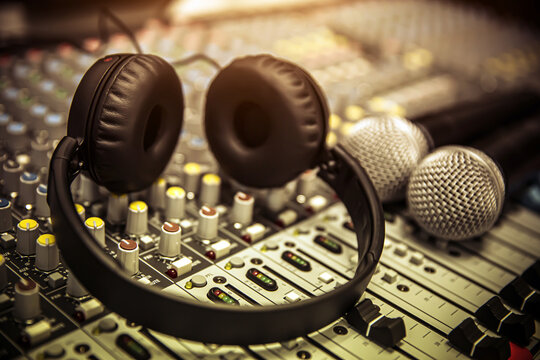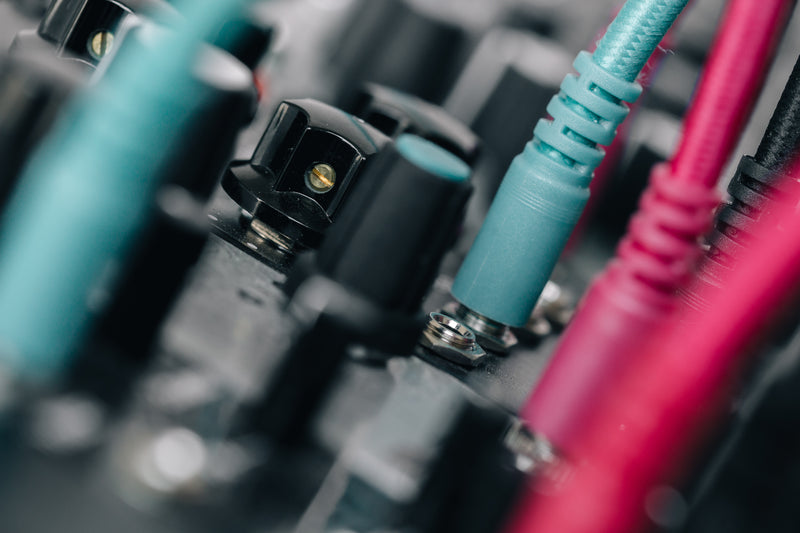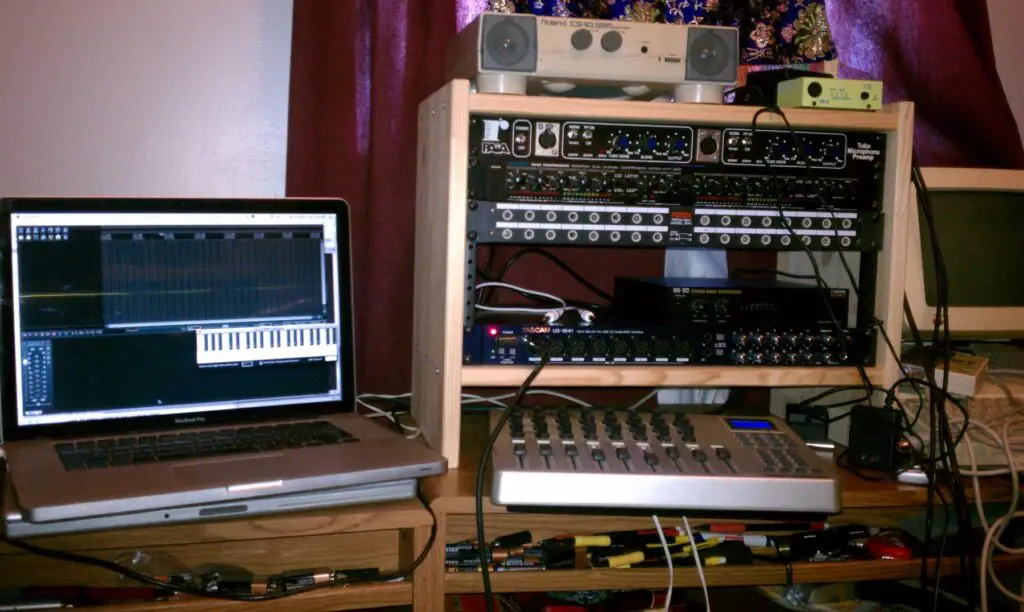Have you ever listened to a song and wondered how it was produced? Or maybe you’ve tried recording your own music but can’t get the sound quite right. Audio production is a complex field that involves various techniques and equipment, but at its core lies a fundamental understanding of the basics. In this blog post, we’ll explore the essentials of audio production and provide an in-depth look at what it takes to create high-quality recordings. Whether you’re a musician, podcaster, or just curious about the process, this guide will give you a solid foundation for understanding the world of audio production. So let’s dive in and discover what it takes to create great-sounding audio!
Table of Contents
What is Audio Production? A Comprehensive Guide to the Basics
Audio production is the process of creating, manipulating and refining recorded sounds to produce a high-quality finished product. It involves various techniques from recording to mixing and final mastering that are used to create audio content for different forms of media such as music albums, films, podcasts, and commercials.
To produce professional-grade audio productions, understanding the fundamentals of sound waves, frequency ranges and digital signal processing (DSP) technology is essential to create standout projects. The primary objective is producing polished audio that meets industry standards while conveying the intended message or emotion.
With knowledge in this area, producers can optimize their work by choosing the right equipment, preparing acoustic environments for optimal acoustics and following best practices when mixing or mastering recordings. These skills will not only ensure project satisfaction but also offer opportunities for career growth in an exciting field filled with endless possibilities.
The Importance of Audio Production in Today’s Media Landscape
Audio production plays a crucial role in today’s media landscape. From music and podcasts to film and TV, high-quality audio is now expected across all platforms. Whether it’s creating a new album or recording a voiceover for a video project, every aspect of audio production can impact how the end product is received by audiences. With advancements in technology, both amateur and professional producers have access to affordable equipment that can produce high-quality results with little experience. However, understanding the basics of audio production is still essential to achieving success. A solid knowledge base will help you choose the right equipment for your needs, ensure proper recording techniques are used, and effectively mix and master tracks for polished final products. By mastering these skills, you’ll be able to create unforgettable pieces of audio content that capture listeners’ attention and leave them wanting more.
The Fundamentals of Audio Production: Understanding Sound Waves and Frequencies
Sound waves are the foundation of audio production. They are created by variations in air pressure that propagate through a medium, such as air or water. The basic unit of sound is called a wave cycle; it comprises one positive and one negative peak.
The perceived pitch of a sound corresponds to its frequency, which is measured in hertz (Hz). Higher frequencies correspond to higher pitches and vice versa. Frequency response, or the range of audible frequencies produced by an audio system, is an essential consideration when choosing equipment for your audio production needs.
Another crucial factor is sound pressure level (SPL), which is measured in decibels (dB) and refers to the volume or intensity of an audio signal. SPL can have significant effects on both hearing health and overall quality of recorded sounds. It’s important to ensure that you choose equipment with appropriate frequency response capabilities and SPL ratings for optimal results in your audio productions.
How to Choose the Right Equipment for Your Audio Production Needs
Identifying Your Audio Production Goals: Choosing Equipment Based on Your Objectives
When it comes to choosing equipment for your audio production needs, it’s important to identify your goals beforehand. Are you looking to record music or podcasts? Do you need equipment for live events or studio recording? Identifying these key factors will help narrow down the type of gear necessary for a successful project. It’s also crucial to consider budget and level of experience when selecting equipment. While high-end gear may be ideal, it can come with a hefty price tag that may not align with your budget. On the other hand, investing in low-quality equipment can hinder the overall quality of your audio production.
Considerations for Home Studio Setups: Finding the Right Gear at an Affordable Price
When setting up a home studio for audio production, it’s important to find the right gear that fits your needs and budget. Audio interface is a crucial piece of equipment that connects your computer to microphones and other instruments. Look for one with high-quality preamps and multiple inputs if you plan on recording multiple sources simultaneously. Studio monitors are also essential for accurate sound reproduction. Avoid using consumer-grade speakers as they may color the sound and affect your mixing decisions. Other important gear includes microphones, headphones, and cables. Research and compare different options to find the best value for your budget.
Amplifying Your Sound Quality: Understanding Microphones and Preamps for Pro-Level Recording
When it comes to audio production, choosing the right equipment is crucial to achieving quality results. Two key pieces of equipment to focus on are microphones and preamps. Microphones come in different types – dynamic, condenser, and ribbon – each with their own unique qualities that suit specific recording situations. Preamps amplify the microphone’s signal before it reaches the recording device, thus having a major impact on sound quality. There are many factors to consider when selecting a preamp such as impedance matching and gain control. Investing in high-quality microphones and preamps can elevate your recordings from amateur level to professional grade.
The Importance of Mixing and Mastering: Investing in Monitors, Headphones, and Room Treatment
Investing in high-quality monitors, headphones, and room treatment is crucial for achieving professional-grade mixing and mastering in audio production. Monitors are essential for accurately hearing the nuances of your recordings, while headphones provide a different perspective and allow for more detailed editing. Room treatment helps to minimize unwanted reflections and resonances that can negatively impact the final product. When choosing equipment, consider factors such as frequency response, sensitivity, and impedance. Investing in quality equipment may require a higher upfront cost, but it will ultimately save time and money by producing better results and reducing the need for costly revisions.

The Art of Recording: Tips and Tricks for Capturing High-Quality Audio
Choosing the Right Microphone for Your Recording Needs
When it comes to capturing high-quality audio, choosing the right microphone is absolutely crucial. There are many different types of microphones available, each with its own strengths and weaknesses. Dynamic microphones are ideal for recording loud sounds, such as drums or electric guitars, while condenser microphones are better suited for capturing quieter acoustic instruments or vocals.
It’s also important to consider the pickup pattern of your microphone. Cardioid mics pick up sound from directly in front of them, making them great for solo vocalists or podcast hosts. Omni-directional mics capture sound from all directions, which can be useful if you’re recording a group conversation.
No matter what type of mic you choose, make sure it’s compatible with your recording setup and that you position it correctly during recording to get the best possible sound quality.
Setting Up Your Recording Space for Optimal Sound Quality
To capture high-quality audio, it’s essential to have an optimal recording space. Acoustic treatment is key in minimizing unwanted noise and ensuring a clear recording. Begin by finding a quiet room with minimal external noise interference. Then, add sound-absorbing materials such as acoustic foam panels or insulation to walls, floors, and ceilings. Avoid reflective surfaces like glass or metal that can cause echo and dampen the sound with heavy curtains or blankets if necessary.
Next, consider the microphone placement; place the mic at least 6-12 inches away from any surface to prevent reflections. Experiment with different positions until you find one that captures the desired sound quality.
Lastly, use headphones to monitor your recordings for accuracy and adjust EQ settings accordingly.
Tips for Capturing Clear and Consistent Audio Levels
To capture high-quality audio in your production, it’s important to ensure that your audio levels are consistent and clear. To achieve this, start by selecting the right microphone for the job. Choose a directional microphone for interviews or vocals, and an omnidirectional mic for capturing ambient sound. Next, adjust the gain level on your recorder to prevent clipping and distortion. Place your microphone close to the source of sound without touching it, and monitor the levels throughout recording using headphones or a meter. Remember that editing can only do so much – capturing good audio from the start is key to achieving professional results.
Understanding the Importance of Post-Production Editing in Audio Production
Post-production editing plays a crucial role in audio production, especially when it comes to achieving high-quality sound. This process involves refining, enhancing and correcting audio recordings after they’ve been captured and mixed down. It is during this stage that unwanted noise or distortion is removed, levels are balanced, and effects such as equalization or compression are added to make the audio sound more polished and professional. Some of the key techniques used in post-production include noise reduction, EQ, dynamics processing, reverb/delay effects, and mastering. Through careful editing and attention to detail during post-production, you can take your audio productions from good to great!
Mixing and Mastering: Techniques for Polishing Your Audio Production
After recording your audio, it’s time to start mixing and mastering it. Mixing involves adjusting the individual tracks of an audio production to create a final stereo mix that sounds balanced and cohesive. This includes adjusting volume levels, panning, equalization (EQ), compression, reverb, delay, and other effects.
Mastering is the process of taking a finished mix and preparing it for distribution by optimizing its sound quality for different playback systems (e.g., speakers vs. headphones). This can involve applying EQ adjustments to balance out any frequency imbalances or adding subtle saturation or compression to give warmth and depth.
To avoid overloading your ears during mixing sessions, take periodic breaks to let them rest. When mastering your audio project make sure you listen on different devices such as headphones or car speakers which will reveal sonic problems that might not be obvious in studio monitors.
Remember that polishing is about achieving the right balance between all elements of the track while keeping in mind where this music will ultimately end up i.e radio airplay or streaming services; each platform has different requirements regarding loudness so clipping must be avoided at all costs!

Understanding Acoustics: Creating the Perfect Environment for Your Audio Projects
Acoustic treatment is a crucial aspect of creating a suitable environment for audio production. It involves controlling the way sound behaves in a room to ensure that the sound you record or mix is as accurate as possible. This means reducing unwanted reflections, echoes, and other acoustic anomalies that can affect the quality of your audio.
One way to achieve this is by using sound-absorbing materials such as acoustic foam panels, bass traps, and diffusers. These materials help to absorb or scatter sound waves, preventing them from bouncing around the room and causing problems.
Another important consideration is room layout**. Placing your speakers and other equipment in the right position can help to minimize unwanted reflections and improve the accuracy of your monitoring.
Finally, it’s important to consider noise isolation. If you’re recording audio, you’ll want to make sure that external sounds don’t interfere with your recordings. This might involve using soundproofing materials or choosing a suitable location for your recording space.
By taking these factors into account, you can create an acoustically optimized environment that will help you achieve the best possible results in your audio production projects.

Troubleshooting Common Audio Production Problems: Tips and Tricks for Success
Troubleshooting common audio production problems can be a daunting task, but with the right techniques, you can overcome any challenge. One of the most common issues is background noise, which can be caused by a variety of factors such as poor microphone placement or electrical interference. To combat this, try using a noise gate or investing in a better quality microphone. Another issue is distortion, which can occur when levels are too high. To prevent this, make sure to monitor your levels and adjust accordingly. Finally, proper EQ is crucial for achieving a balanced mix. If your audio sounds muddy or lacks clarity, try adjusting the EQ to bring out certain frequencies. Remember to always listen critically and make adjustments as needed to ensure the best possible outcome for your audio production project.

The Role of Audio Production in Film, TV, and Music Industries
Audio production plays a crucial role in the film, TV, and music industries. In film and TV, audio production is responsible for capturing dialogue, sound effects, and music to create a cohesive audio experience for the audience. In music, audio production involves recording and mixing tracks to create a polished final product.
One important aspect of audio production in these industries is foley sound. Foley sound refers to the creation of sound effects in post-production that are added to enhance the audio experience. For example, footsteps or the sound of a door closing may be added in post-production to make a scene feel more realistic.
Another key aspect of audio production in these industries is sound design. Sound design involves creating unique sounds or manipulating existing sounds to create a specific mood or atmosphere. This can be especially important in horror or sci-fi films where sound can play a major role in creating tension and suspense.
Overall, audio production is an essential part of creating high-quality media content in these industries and requires skilled professionals who understand the technical aspects of capturing and manipulating sound.
Career Opportunities in Audio Production: Exploring Your Options
Audio production is a vast field that offers a wide range of career opportunities. Whether you’re interested in music, film, television, or advertising, there are plenty of paths to explore. Some popular careers in audio production include sound engineer, recording engineer, mixing engineer, mastering engineer, and audio technician.
Sound engineers are responsible for capturing and manipulating sound during live events such as concerts or theater performances. Recording engineers work in studios to record and edit music or other audio projects. Mixing engineers blend different tracks together to create a cohesive sound while mastering engineers put the finishing touches on the final product.
Audio technicians work behind the scenes to set up and maintain equipment for live events or recording sessions. Other career options include music producer, foley artist, voice-over artist, and sound designer.
To succeed in this field, it’s important to have a strong understanding of audio production techniques and equipment. Many professionals also have degrees in fields such as music production or audio engineering. With the right skills and experience, a career in audio production can be both rewarding and lucrative.
In conclusion, audio production is a complex and fascinating field that plays an essential role in our media landscape. Understanding the basics of sound waves, equipment, recording techniques, and mastering is crucial for producing high-quality audio that audiences will love. Whether you are a seasoned professional or new to the industry, there is always something new to learn about this exciting field. So why not check out some of our other content on audio production? We have plenty of tips and tricks to help you take your skills to the next level! Thank you for reading this comprehensive guide – we hope it has been informative and helpful for you.

